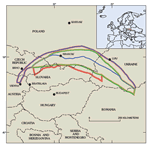 Abstract Abstract
Three total petroleum systems were
identified in the North Carpathian Province (4047) that
includes parts of Poland, Ukraine, Austria, and the Czech
Republic. They are the Isotopically Light Gas Total Petroleum
System, the Mesozoic–Paleogene Composite Total Petroleum
System, and the Paleozoic Composite Total Petroleum System.
The Foreland Basin Assessment Unit of the Isotopically
Light Gas Total Petroleum System is wholly contained
within the shallow sedimentary rocks of Neogene molasse
in the Carpathian foredeep. The biogenic gas is generated
locally as the result of bacterial activity on dispersed
organic matter. Migration is also believed to be local,
and gas is believed to be trapped in shallow stratigraphic
traps.
The Mesozoic–Paleogene Composite
Total Petroleum System, which includes the Deformed Belt
Assessment Unit, is structurally complex, and source
rocks, reservoirs, and seals are juxtaposed in such a
way that a single stratigraphic section is insufficient
to describe the geology. The Menilite Shale, an organic-rich
rock widespread throughout the Carpathian region, is
the main hydrocarbon source rock. Other Jurassic to Cretaceous
formations also contribute to oil and gas in the overthrust
zone in Poland and Ukraine but in smaller amounts, because
those formations are more localized than the Menilite
Shale.
The Paleozoic Composite Total Petroleum
System is defined on the basis of the suspected source
rock for two oil or gas fields in western Poland. The
Paleozoic Reservoirs Assessment Unit encompasses Devonian
organic-rich shale believed to be a source of deep gas
within the total petroleum system. East of this field
is a Paleozoic oil accumulation whose source is uncertain;
however, it possesses geochemical similarities to oil
generated by Upper Carboniferous coals.
The undiscovered resources in the
North Carpathian Province are, at the mean, 4.61 trillion
cubic feet of gas and 359 million barrels of oil. Many
favorable parts of the province have been extensively
explored for oil and gas. The lateral and vertical variability
of the structure, the distribution and complex geologic
nature of source rocks, and the depths of potential exploration
targets, as well as the high degree of exploration, all
indicate that future discoveries in this province are
likely to be numerous but in small fields.
|

 Abstract
Abstract
